The spread of Islam in Bangladesh took root during the Sultanate period, leaving behind a rich legacy of historical mosques. Today, Bangladesh, aptly known as the “City of Mosques,” boasts numerous structures that stand as testaments to faith, architecture, and resilience. While many mosques haven’t survived the ravages of time, those that remain offer a glimpse into Bangladesh’s vibrant Islamic heritage. In this article, we explore the top ten historical mosques in Bangladesh, each one a captivating story waiting to be discovered.
Top 10 Historical Mosques in Bangladesh
1. Sixty Dome Mosque: A UNESCO World Heritage Marvel
Bangladesh is home to three distinct UNESCO World Heritage Sites, and the Sixty Dome Mosque stands proudly among them. There’s no precise information about its builders or exact construction date, but architectural clues point towards Khan Jahan’s hand in its creation. This ancient mosque, nestled in Bagerhat district’s southwest corner, is believed to have risen in the 15th century. Standing the test of time and significant expense, Bagerhat’s Sixty Dome Mosque earned its coveted World Heritage status from UNESCO in 1985.
The mosque stretches roughly 160 feet north to south, with an internal length of 143 feet. Its east-west expanse measures 104 feet, while the interior width is 88 feet. The walls themselves are a sturdy 8.5 feet thick. As for the famed domes, their number seems to have sparked some debate. While 81 might be the technical count (11 domes in 7 rows + 4 corner domes), the passage of time has cemented “Sixty Domes” in popular parlance, and the mosque’s moniker reflects this endearing nickname.
Key Highlights:
- UNESCO World Heritage Site since 1985
- Built in the 15th century
- Located in Bagerhat district
- 81 unique domes (popularly known as Sixty Dome Mosque)
- Architectural masterpiece of Khan Jahan Ali
Historical Significance: Constructed during Sultan Nasiruddin Mahmud Shah’s reign (1435-59), this mosque represents the pinnacle of medieval Islamic architecture in Bangladesh.
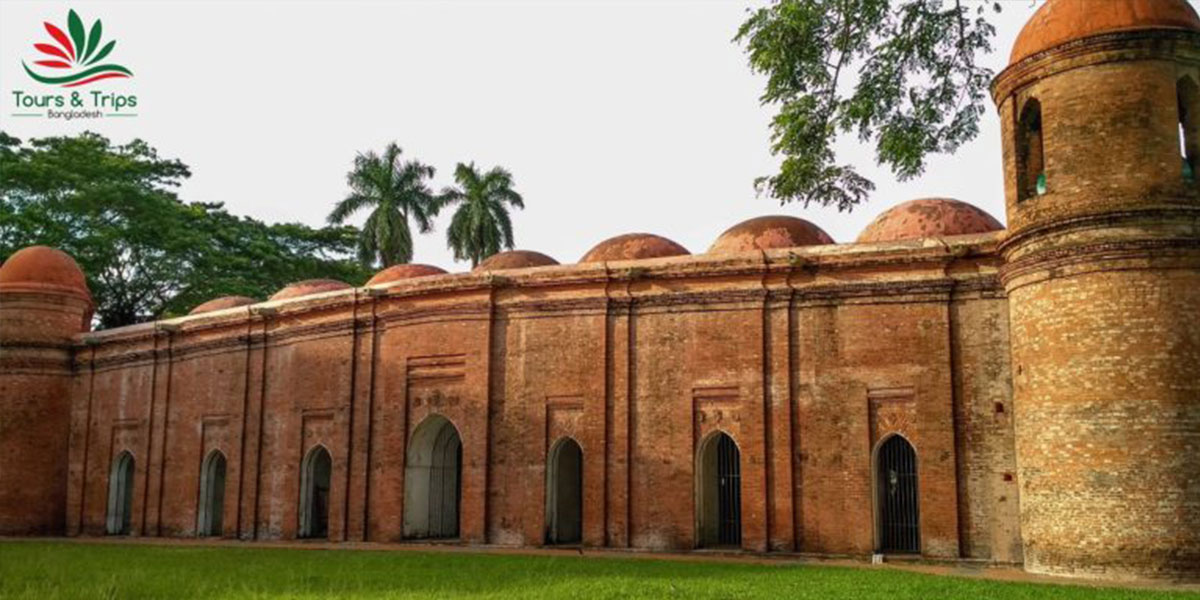
Quick facts about the Sixty Dome Mosque:
- The mosque is made of brick and has a rectangular shape. The walls are 8.5 feet thick.
- The interior of the mosque is divided into 11 aisles by 10 rows of columns.
- The central mihrab is the largest and most ornate mihrab in the mosque.
- There is a small door next to the central mihrab on the north side of the mosque.
Over time, the 81 domes (or perhaps 77, as previously mentioned) became commonly known as the Sixty Domes, eventually earning the name Sixty Domes Mosque. During Sultan Nasiruddin Mahmud Shah’s reign (1435-59), Azam Uluq Khan Jahan Khan established the Khalifabad Kingdom near the Sundarbans. Khan Jahan also constructed a courtroom for meetings, which later transformed into the magnificent Sixty Domes Mosque.
Stepping inside the mosque, visitors encounter ten mihrabs adorning the west wall. The central mihrab stands out for its grandeur, while five additional mihrabs grace the south wall and four embellish the north. An interesting detail emerges beside the central mihrab on the north side: instead of the expected mihrab, a small door stands in its place. This captivating quirk adds to the mosque’s rich history and intrigue.
The Sixty Domes Mosque stands as a testament to Bangladesh’s architectural heritage and its enduring legacy. While it’s just one of Bagerhat district’s treasures, its captivating beauty and historical significance make it a must-visit for any traveler seeking a glimpse into Bangladesh’s vibrant past.
2. Chunakhola Mosque: Historical Mosques in Bangladesh
Key Features:
- 15th-century mosque
- Located in Bagerhat district
- Unique architectural style
- Renovated with UNESCO support
- Square building with thick walls
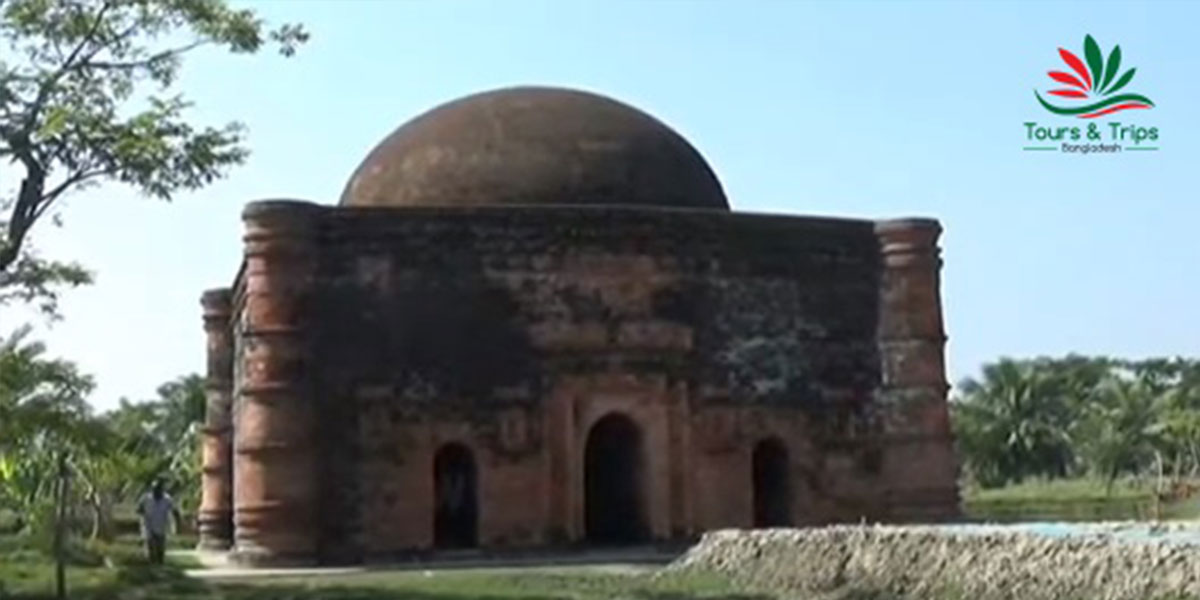
Quick facts about the Chunakhola Mosque
- The walls of the 7.7 sq m square building are 2.24 m thick.
- It has 3 doorways on the east side and one entrance on the north and south sides.
- Three mihrabs grace the interior, with the central one being the largest.
Chunkhola Mosque is an antiquity located in the Bagerhat district of Bangladesh. Dating back to the fifteenth century, the mosque is situated in the village of Chunkhola. The architectural style of the mosque differs from other styles built by Khan Jahan Ali.
The mosque features a half-dome. The brick walls were demolished and renovated in 1980 with the help of UNESCO. This mosque ranks among the top ten historical mosques in Bangladesh.
Check our tour packages Land Of Smile.
3. Kusumba Mosque: A Stone Testament to Afghan-Era Artistry
Nestled in the village of Kusumba, Manda Upazila, Naogaon District, Bangladesh, stands the Kusumba Mosque, a magnificent testament to Afghan-era artistry. Built during Ghiyasuddin Bahadur Shah’s reign, the last ruler of the Suri dynasty, the mosque was constructed by Sulaiman in 966 AH (1558-59 AD), as noted on a plaque at its entrance.
Clad in dark stone, the mosque rises gracefully on the west bank of the Kusumba Dighi. Its rectangular form embraces three mihrabs – prayer niches indicating the direction of Mecca – each crafted from the same somber stone. The central mihrab stands independent from the western wall, while two smaller ones flank the central passageway, mirroring its design on the floor. This unique three-mihrab configuration is a rarity in mosque architecture.
Intricate floral and vine motifs embellish the mihrabs, echoing the herbal patterns adorning the mosque’s overall design. Six rounded domes, arranged in two rows, crown the structure, while a slightly curved cornice and engaged rectangular towers add Bengali flair to the predominantly Afghan architectural style.
Unique Characteristics:
- Built in 1558-59 AD
- Constructed during Suri dynasty
- Dark stone architecture
- Featured on Bangladeshi five-taka note
- Surrounded by 25.83-acre Kusumba Dighi reservoir
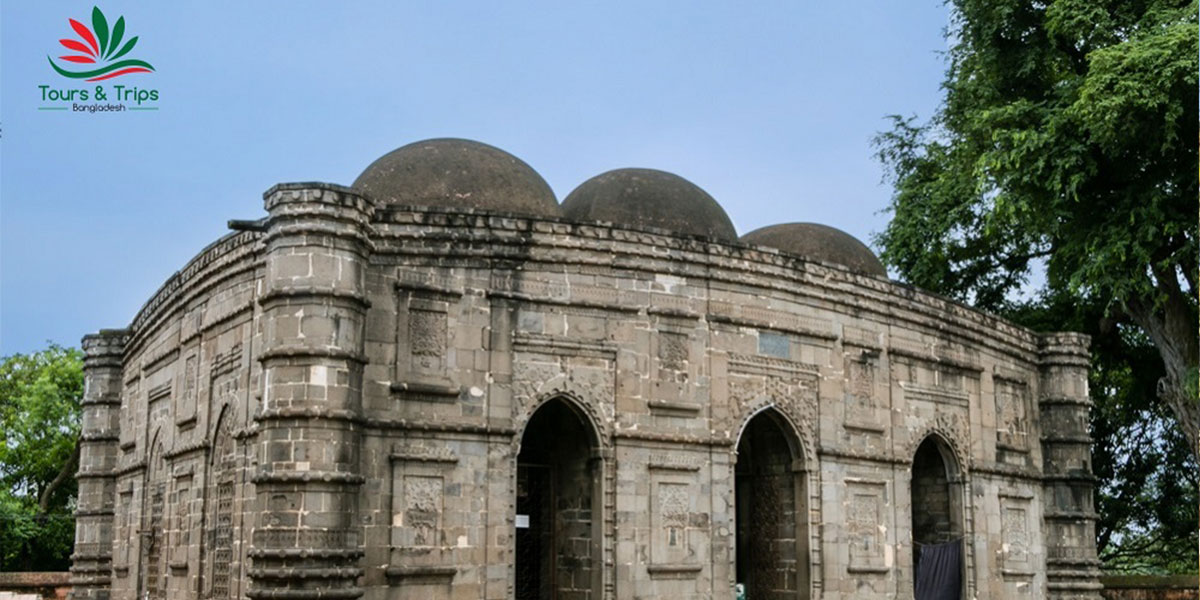
Quick facts about the Kusumba Mosque
- Location: Village of Kusumba, Manda Upazila, Naogaon District, Bangladesh
- Construction: 966 AH (1558-59 AD) during the reign of Ghiyasuddin Bahadur Shah, the last ruler of the Suri dynasty
- Material: Dark stone
- Layout: Rectangular form with three mihrabs (prayer niches) – one central and two flanking the central passageway
- Interior: Spacious prayer hall divided into three naves and two aisles, light streaming through entrances on the eastern, north, and south sides, raised platform in the northwest corner possibly used by judges in the past
- Exterior: Surrounded by a vast 25.83-acre reservoir called the Kusumba Dighi, which reflects the mosque’s grandeur and enhances the tranquility of the landscape
- Significance: Featured on the Bangladeshi five-taka note, stands as a beacon of cultural heritage and architectural brilliance
Stepping inside, one is greeted by a spacious prayer hall divided into three naves and two aisles. Light streams through three entrances on the eastern facade and one each on the north and south sides. In the northwest corner, a raised platform atop a pillar whispers of the mosque’s past. Legend has it that judges of the era used this platform to address local matters, adding to the mosque’s historical significance.
Beyond the mosque itself, a vast reservoir spanning 25.83 acres completes the scene. This serene pool, known as the Kusumba Dighi, reflects the mosque’s grandeur and enhances the tranquility of the surrounding landscape.
Featured on the Bangladeshi five-taka note, the Kusumba Mosque stands as a beacon of cultural heritage and architectural brilliance. Its unique blend of Afghan and Bengali influences makes it a must-visit for anyone seeking a glimpse into Bangladesh’s rich history and captivating artistry.
4. Goaldi Mosque: Bengal Sultanate Architectural Brilliance
Established in 1519 during Sultan Alauddin Husain Shah’s reign, Goaldi Mosque in Sonargaon, Bengal, reflects the rich history and architectural prowess of the Bengal Sultanate. Built by Mulla Hizabar Akbar Khan, it features an enclosed square architecture with a cubical prayer chamber, circular corner towers, and entrances on all sides except the qibla wall. The mosque’s single dome, ribbed turrets, and relief work on the east facade contribute to its elegant design.
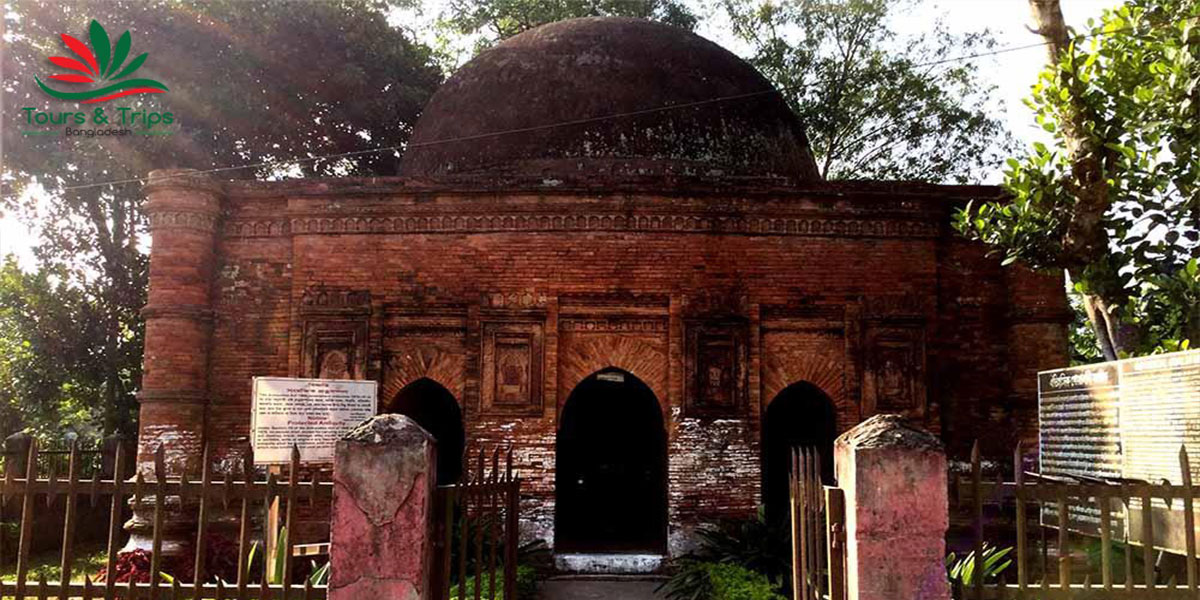
Quick facts about the Goaldi Mosque, Historical Mosques in Bangladesh
- Built in 1519 under Sultan Alauddin Husain Shah
- Showcases Bengal Sultanate architecture
- Enclosed square with a single dome and ribbed turrets
- Three mihrabs, central one in black basalt with intricate patterns
- Served as a religious & strategic center during the Sultanate
- Expanded in 1705 under Mughal rule
The qibla wall houses three mihrabs, with the central one in black basalt adorned with intricate patterns. The flanking mihrabs feature brick and terra cotta work with lotus motifs. Goaldi Mosque served as a religious center during the Bengal Sultanate, witnessing strategic launches into Assam, Tripura, and Arakan from Sonargaon, reflecting its historical significance as a royal capital.
In 1705, Abdul Hamid added a single-domed structure during Aurangzeb’s reign, highlighting the region’s enduring cultural and architectural significance. To explore this historical gem, take a bus from Dhaka to Sonargaon, specifying Mograpara as the destination. From Mograpara Crossing, a rickshaw to Sonargaon costs a nominal fee of 20 taka, with a journey time of approximately 40 minutes.
Check out our tour packages Dhaka & Sonargoan.
5. Choto Sona Mosque: The “Small Golden Mosque”
The small Sonamasjid is known as the ‘jewel of Sultanate architecture’. Choto sona mosque is locally called as choto sona masjid or small golden mosque. It had a golden coating on the outside, which shone like gold when exposed to sunlight, The fifteen dooms of the mosque including three chau-chala domes in the middle row, once gilded, so derives its name from that fact.
The mosque was built by a man named Wali Mohammad between 1493 to 1519 during the time of Sultan of Bengal Alauddin Husain Shah. It was set up at Pirojpur village on the edges of Gaur, the capital of antiquated Bengal, which presently falls under the Shibganj thana of Chapainawabganj region of Rajshahi division.
Fascinating Facts:
- Built between 1493-1519
- Nickname: “Jewel of Sultanate Architecture”
- Originally had gilded domes
- 15 domes, including unique chau-chala designs
- Located in Pirojpur village
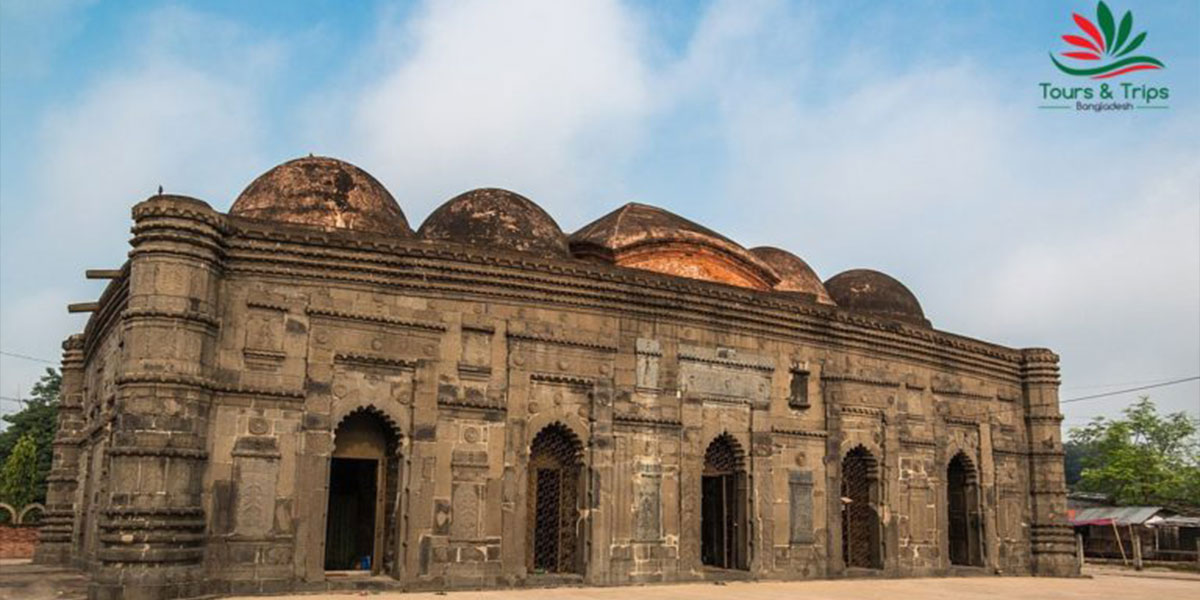
Quick Facts about the Choto Sona Mosque
- Nickname: “Jewel of Sultanate architecture
- Meaning of name: “Small Golden Mosque” (due to former gilded domes)
- Age: Built 1493-1519
- Location: Pirojpur village, Chapainawabganj, Bangladesh
- Dimensions: 82′ x 52.5′
The outer side of the mosque is 82 feet long in the north-south and 52.5 feet wide in the east-west. There are four pinnacles in the four corners of the mosque Their land design is octagonal. The towers have step-by-step ring work. The height of the towers is up to the cornice of the roof.
Check our tour packages All In One Bangladesh.
6. Bagha Mosque: A Sultanate Architectural Masterpiece
For tourist places in Bangladesh, this mosque is one of the attractions in Bangladesh. The mosque was established in 1523 by Ruler Nasiruddin Nusrat Shah, the son of Alauddin Shah, the founder of the Hussain Shahi dynasty. The mosque is situated on 256 bighas of land. The columns and carvings on the north side of the entrance have been destroyed. The mosque has 10 domes, and inside there are 6 pillars. Additionally, the mosque features 4 arches adorned with extraordinary craftsmanship, with a length of 75 feet, width of 42 feet, and a height of 24 feet 6 inches. The walls are 8 feet wide, and the dome is 42 feet in diameter and 12 feet high.
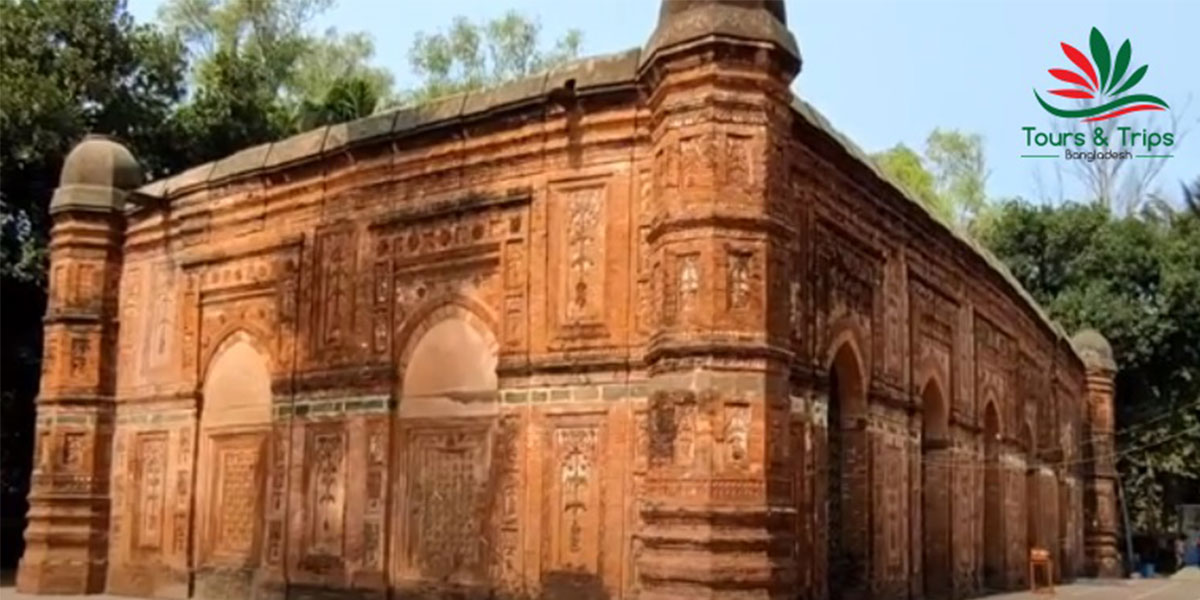
Quick Facts about the Bagha Mosque
- Built in 1523 by Sultan Nusrat Shah, a Hussain Shahi ruler.
- Stands on 256 bighas (64 acres) of land.
- Features 10 domes, 6 interior pillars, and 4 intricately decorated arches.
- Dimensions: 75 ft long, 42 ft wide, 24.5 ft high, walls 8 ft thick.
The Chauchala dome is 20 feet in diameter and approximately 30 feet high. A Persian engraving is present on the central doorway. The mosque’s masonry is made of lime-surki, with arches and pillars on both the inside and outside walls. The Bagha Mosque measures 22.92 meters in length, 12.18 meters in width, and 24 feet 6 inches in height, with walls that are 2.22 meters thick.
The mosque boasts a total of 10 arches, 4 minarets (vault-shaped at the top), and 5 doors. It is surrounded by a wall on all sides and has two entrances on either side of the wall. Ceramic designs adorn both the interior and exterior of the mosque. The large lake near the mosque is also a notable landmark.
7. Sura Mosque: A Unique Architectural Wonder
The Sura Mosque is a sixteenth-century mosque located in the village of ChorGasa, Ghoraghat Upazila, Dinajpur District, Bangladesh. It is also known as the Surmya Masjid or Shuja Masjid. The mosque is believed to have been built around 1504 AD during the Husain Shahi period.
The mosque, built with bricks and black sandstone from the Rajmahal Hills, stands on a raised mound accessible by steps from the east. There’s a big square prayer area topped with a single dome and a porch featuring three domes.
The prayer room is about 4.87 square meters and has a 1.82-meter-wide foreroom on the east side. The whole mosque measures 8.53 meters by 12.50 meters. The kiblah wall, which faces Mecca, features three semicircular mihrab niches with fancy arches, all framed neatly in rectangular designs. The biggest of these mihrabs is the central one, and it’s made of stone.
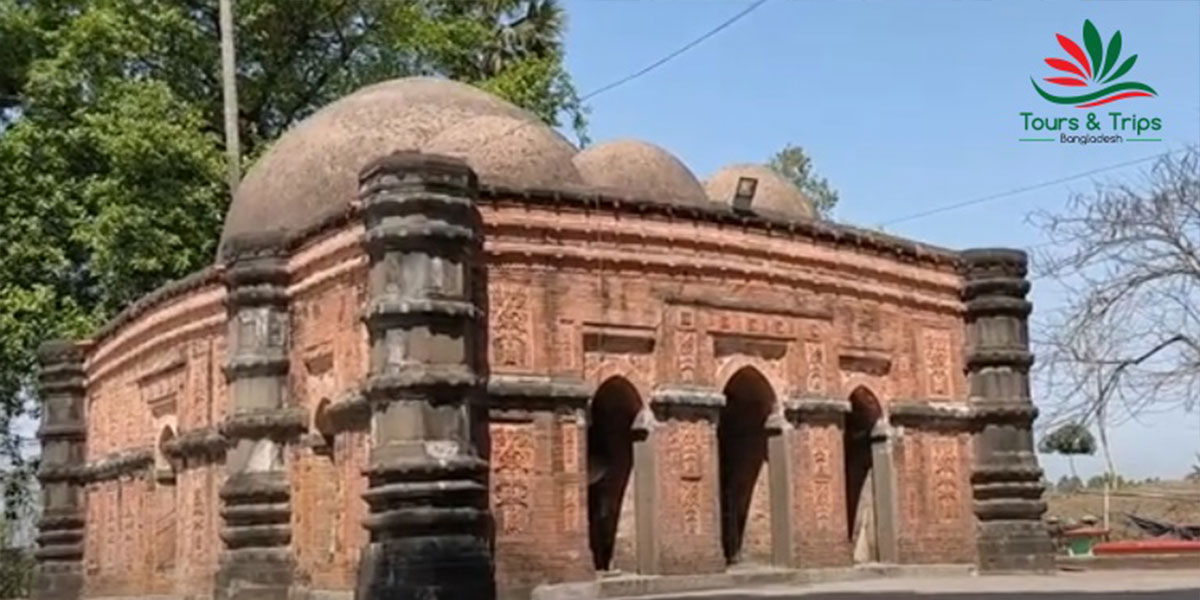
Quick Facts about the Sura Mosque Historical Mosques in Bangladesh
- Location: ChorGasa village, Ghoraghat Upazila, Dinajpur District, Bangladesh
- Age: Built around 1504 AD, during the Husain Shahi period
- Materials: Bricks, stones, black sandstone (from Rajmahal Hills)
- Unique features: High walls (not seen in other Bengali mosques), Terracotta decorations with rosettes, florals, geometrics, Ornate mihrabs with floral, scroll, and geometric designs
The Sura Mosque is a unique example of early Bengali mosque architecture. The mosque has really tall walls that are at the same height as the base, which you won’t find in any other mosque around Bengal. Its surface is covered in terracotta with nice designs like rosettes, flowers, and cool geometric patterns. Inside, the mihrabs are all decked out with flower designs, swirly patterns, and those geometrical styles too.
The Sura Mosque is an important historical and archaeological site in Bangladesh. It is a popular tourist destination and is well worth visiting for anyone interested in Bangladeshi history and culture.
8. Khania Dighi (Rajbibi) Mosque: Royal Elegance
The Khania Dighi Mosque, also known locally as the Chamchika or Rajbibi Mosque, is a attractions of Bangladesh. Its origins remain shrouded in some mystery, with no inscription revealing its exact founding date. However, historians estimate its construction sometime between the early Ilyas Shahi period (1437-1487 AD) and the Husayn Shahi period (1493-1533 AD).
The mosque’s name hints at its possible connection to royalty. “Rajbibi” means “royal lady,” which hints that it could have been created by a woman from the ruling family when Gaur was the capital of Bengal between 1450 and 1565.
Standing gracefully on the western bank of the Khania Dighi tank, the mosque exhibits a simple yet elegant architectural style. Its square-shaped prayer hall measures a modest 8.85 meters per side, with a 2.67-meter wide fore-room leading the way. Three arched openings grace the eastern facade, while single arches adorn the sides of the fore-room and the north and south walls of the main hall.
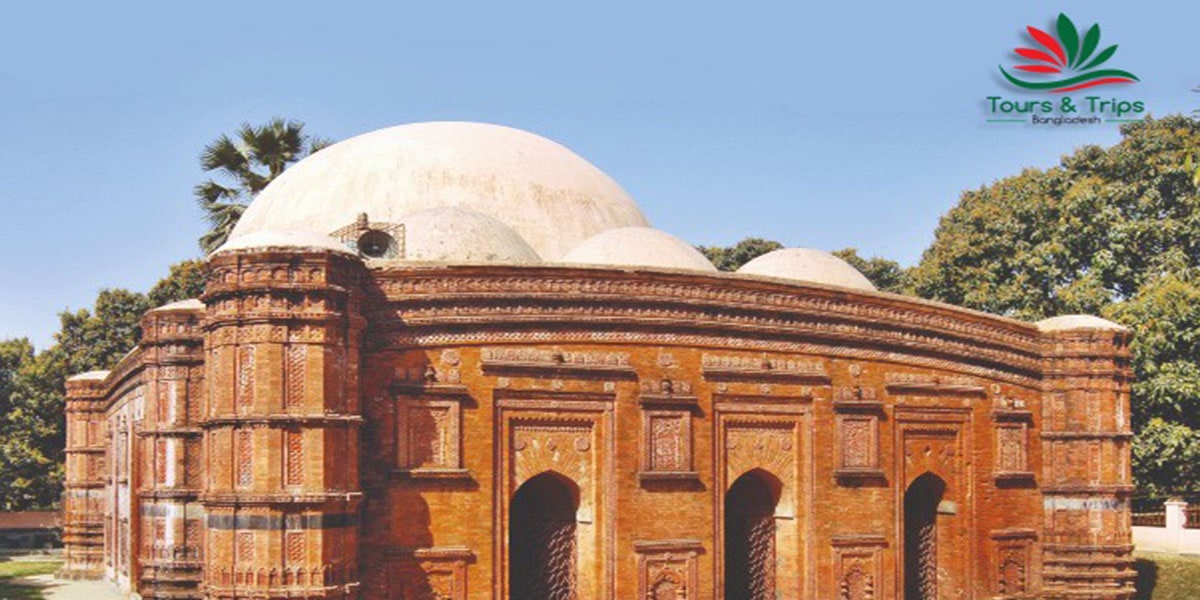
Quick Facts about the Khania Dighi or Rajbibi Mosque
- Age: 15th century (estimated)
- Location: Chapai Nawabganj District, Bangladesh
- Style: Simple, elegant
- Layout: Square prayer hall, fore-room, arched openings
- Key Feature: Central dome resting on squinches and arches
- Interior: Three mihrab niches with intricate cusps
- History: Restored by Bangladesh Directorate of Archaeology
The Khania Dighi Mosque really stands out because of its amazing central dome. It rises beautifully above the prayer hall, sitting on squinches and arches that create a lovely mix of strength and beauty. Inside, the Qibla wall features three mihrab niches, each with intricate frames and multi-foil cusps that add a special artistic touch to this sacred place.
But sadly, over the years, time took its toll on the mosque. By the 1990s, the exterior, the front area, and the corner towers had started falling apart. The Bangladesh Directorate of Archaeology came to the rescue and helped bring the mosque back to its original beauty, making sure it stays preserved for generations to come.
9. Darasbari Mosque: A Medieval Islamic Architectural Gem
The Darasbari Mosque, located near the Indo-Bangladesh border in Shibganj Upazila of Chapainawabganj district, is an important example of early Muslim architecture in Bengal. It was built in 1469 AD during the rule of Sultan Shams Uddin Yusuf Shah. Originally called Firozpur Mosque, it got its current name when Sultan Hussain Shah established Darusbari University in 1502 AD.
This historic mosque, part of Gaur-Lakhnauti in Bangladesh, is among the top ten mosques in the country. The construction reflects ‘Bengali Sultanate Architecture,’ blending local influences with the Sultanate style. Despite being in ruins, the mosque measures 34m by 20.6m externally and 30.3m by 11.7m internally, featuring brick and stone pillars. The roof, with 24 domes and 4 chauchala vaults, has collapsed.
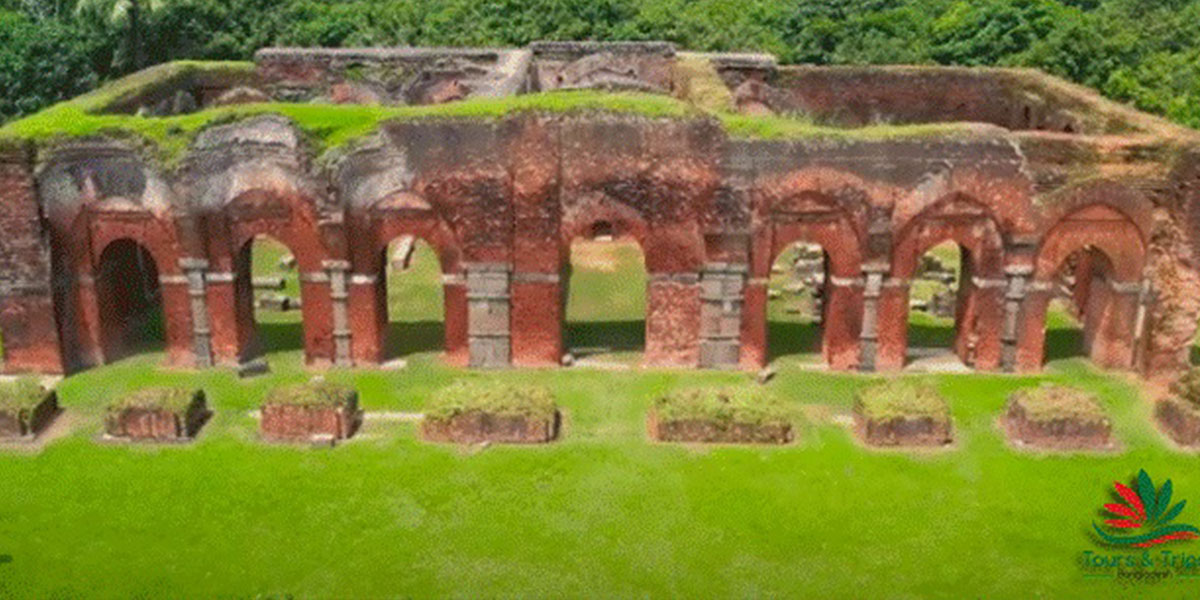
Quick Facts about the Darasbari Mosque
- Location: Shibganj Upazila, Chapainawabganj district, near the Indo-Bangladesh border
- Construction Year: 1469 AD
- Builder: Sultan Shams Uddin Yusuf Shah
- Original Name: Firozpur Mosque
- Renamed: Darasbari Mosque after the establishment of Darusbari University in 1502 AD by Sultan Hussain Shah
- Architectural Style: Bengali Sultanate Architecture, blending local influences with the Sultanate style
- Size: External dimensions 34m by 20.6m, internal dimensions 30.3m by 11.7m
Despite its condition, the Darasbari Mosque showcases detailed terracotta ornamentation inside and outside. The prayer hall has eleven mihrabs and a glimpse of a royal gallery that used to be there. You’ll spot some interesting things like a fallen verandah, a royal gallery in the northwest corner, and those neat octagonal towers poking out at the corners.
This design choice enhances the medieval vibe, offering a glimpse into the past and the architectural ingenuity of that period. The outer walls have these cool vertical patterns that pop out and slide in. Plus, there are terracotta panels that really highlight the Gaur-Lakhnauti decoration style. Although the roof and verandah have collapsed, the mosque’s historical and architectural significance endures, contributing to Bangladesh’s rich cultural heritage.
10.Star Mosque: Architecture Historical Mosques in Bangladesh
The Star Mosque which locals call Tara Masjid is one of the prettiest examples of Islamic design in Bangladesh. You can find it in the historic Armanitola area of Old Dhaka. If you’re into culture, history, or just really enjoy stunning architecture, this mosque is a spot you’ve gotta see.
History and Origin
The Star Mosque was originally built in the 18th century by a local landlord named Mirza Golam Pir. At first, it was just a basic building, but over the years, it got some major updates that turned it into the stunning work of art we see now. The biggest changes happened in the early 20th century when they gave the mosque a cool star design.
Unique Architecture
What makes the Star Mosque stand out is its ornate design and intricate tile work. The mosque is adorned with:
- Star patterns: The white marble walls have these sparkling stars all over them, which is how the mosque got its name.
- Mosaic art is all about creating stunning visuals by arranging small, colorful pieces of ceramic and china. It’s a craft that turns ordinary spaces into vibrant works of art!
- Domes and minarets: The mosque features several domes, with the central dome being the most prominent. One of the most captivating features is the intricate star designs that grace every dome.
Religious and Cultural Significance
The Star Mosque is not just an architectural gem; it is also an active place of worship for Muslims. Visitors are welcome to explore the mosque, provided they respect the sanctity of the space and adhere to proper etiquette.
Conclusion: Historical Mosques in Bangladesh
These historical mosques are more than architectural marvels; they are living narratives of Bangladesh’s Islamic cultural heritage. Each mosque tells a unique story of artistic innovation, religious devotion, and historical transformation.
Travel Tips for Historical Mosques in Bangladesh
- Best time to visit: October to March
- Recommended cities: Bagerhat, Chapainawabganj, Dinajpur
- Respect local customs and dress modestly
- Guided tours available in major historical sites


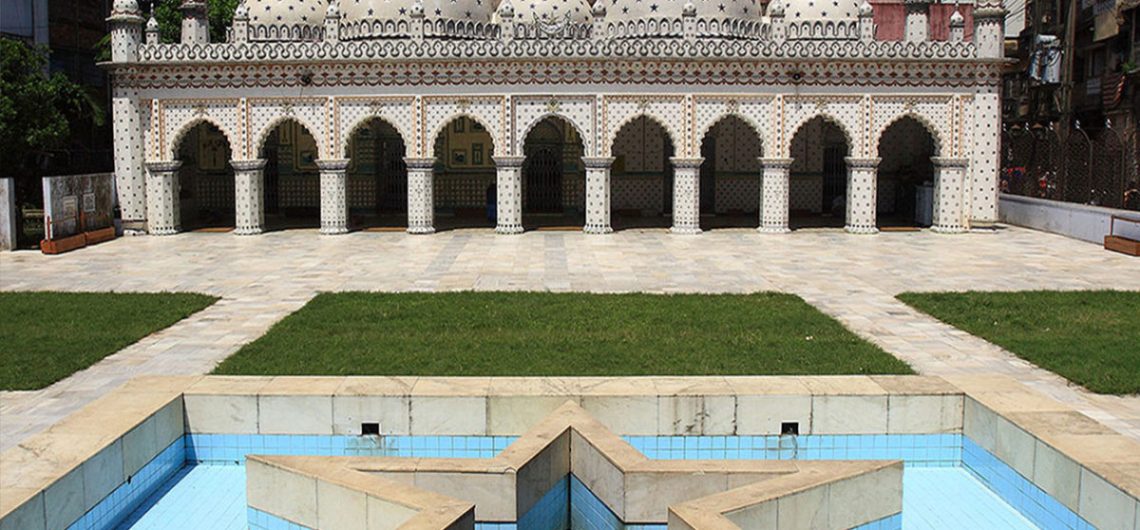
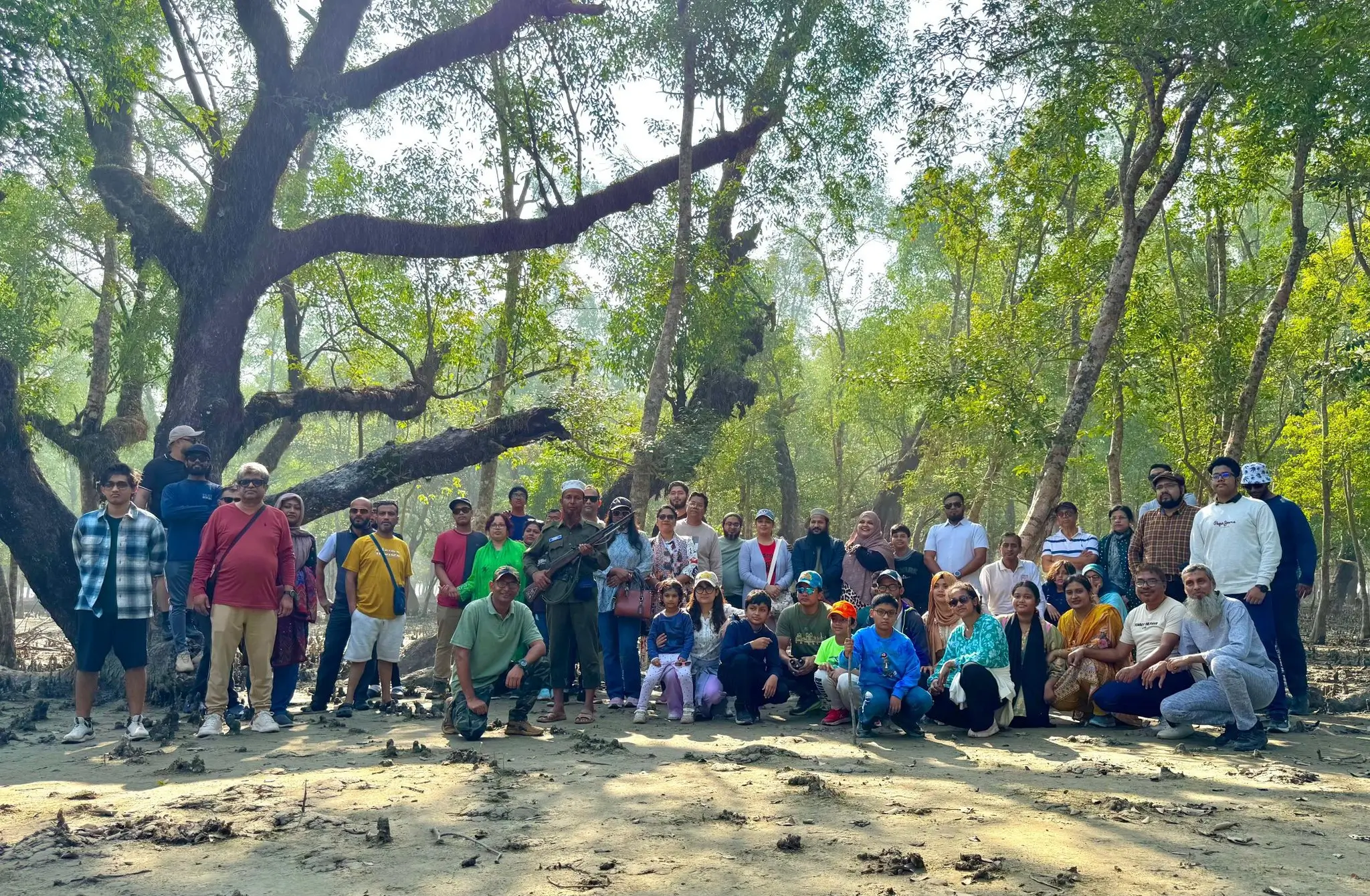

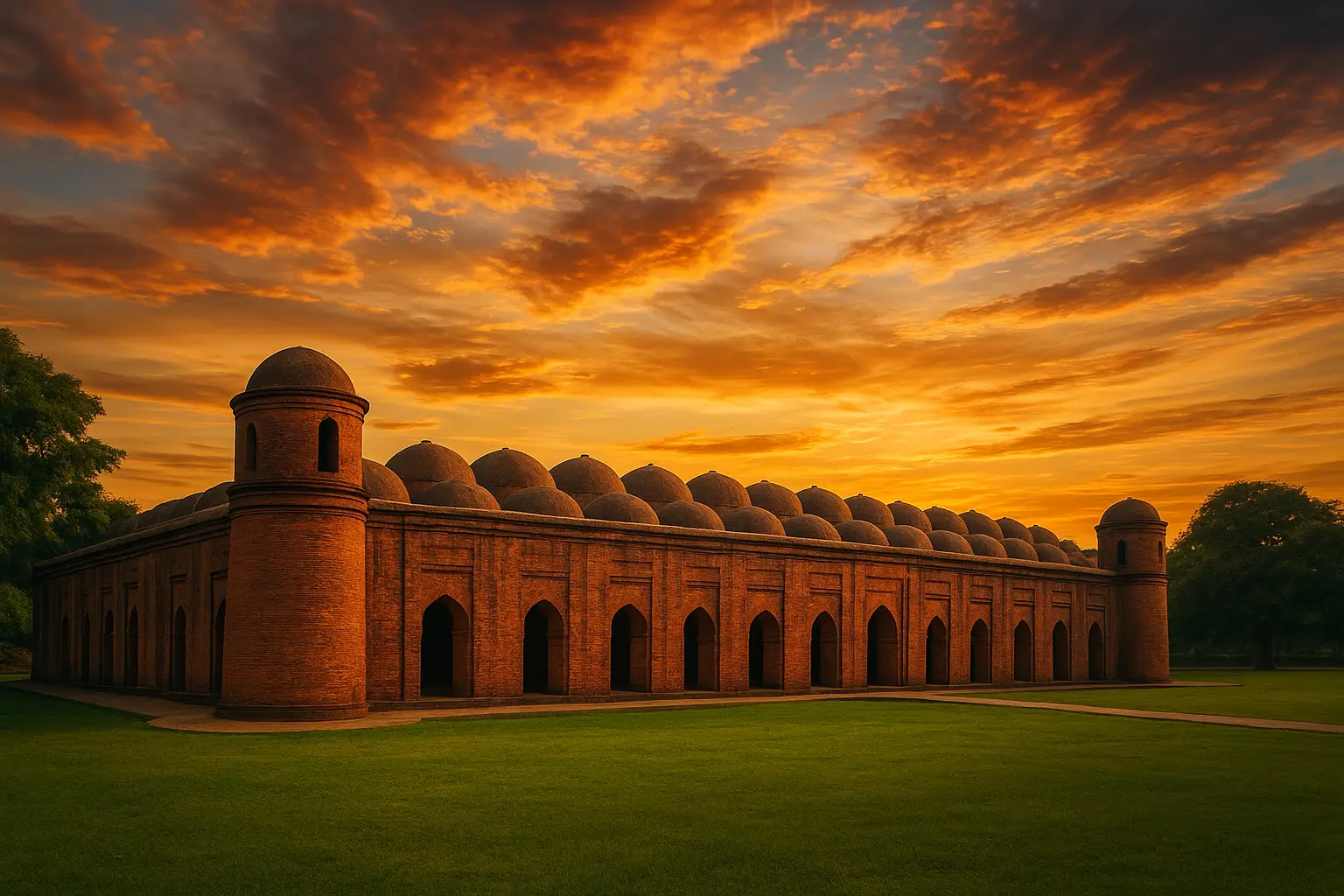
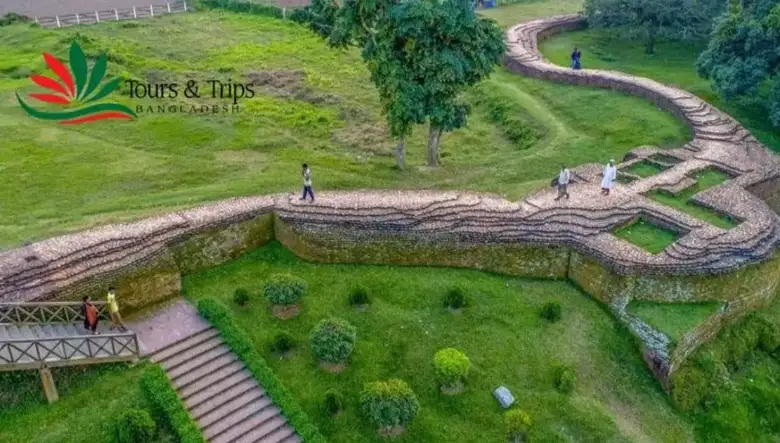
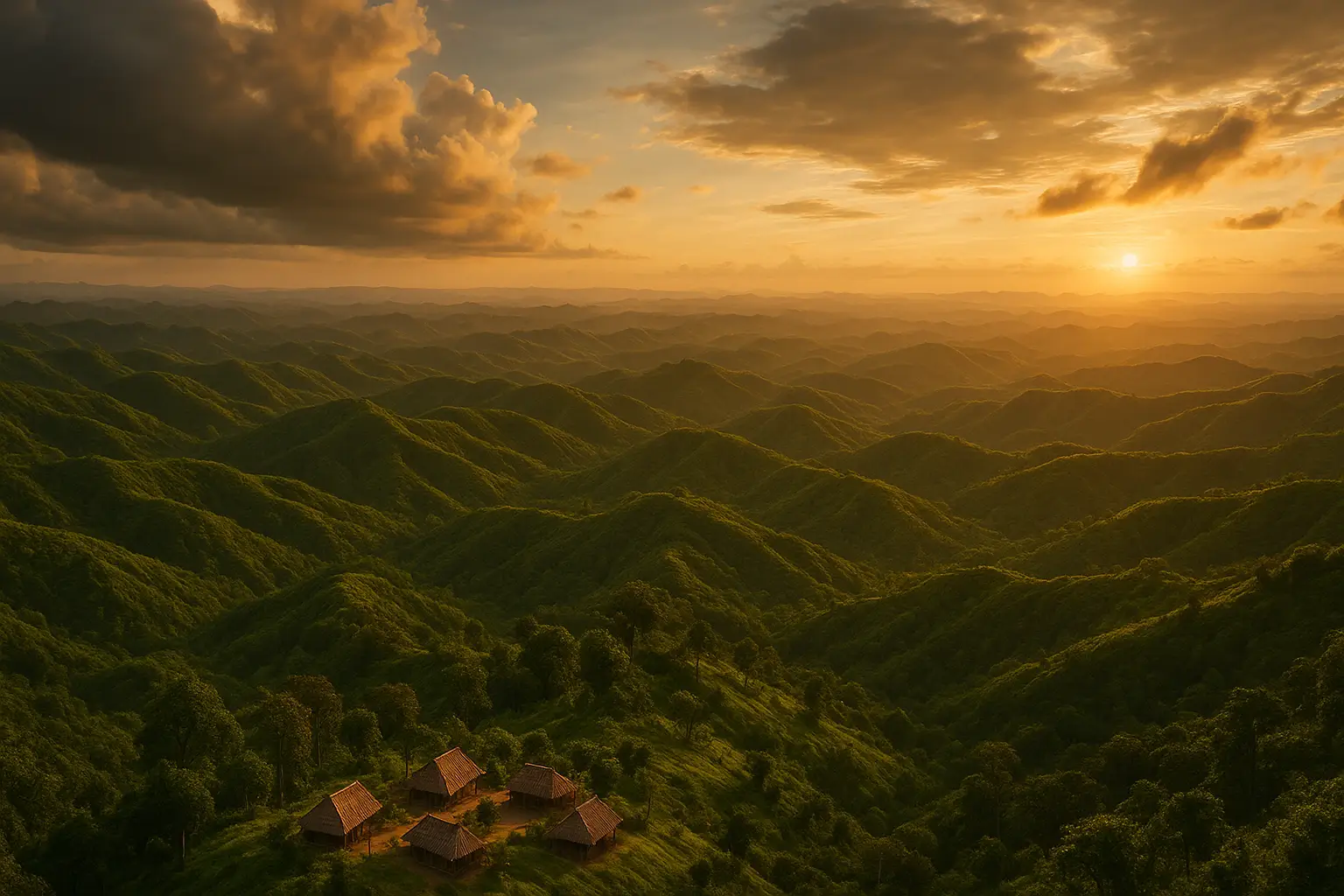



Comments